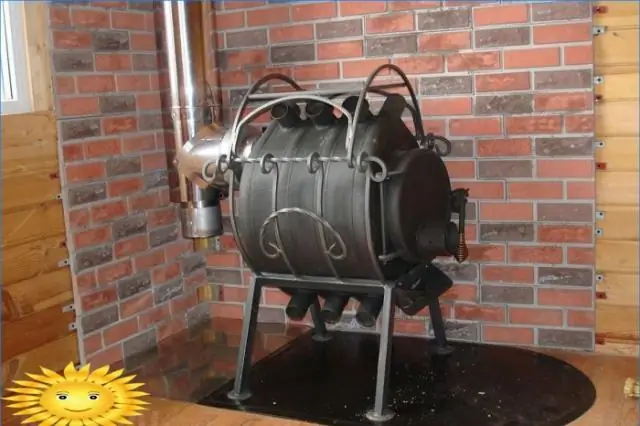
Table of contents:
- Author Bailey Albertson [email protected].
- Public 2023-12-17 12:53.
- Last modified 2025-01-23 12:41.
How to decorate a garden with your own hands - original paths

The days when suburban areas were used by townspeople exclusively for growing their own products, which will allow them not to spend money in stores during the winter, are long over. Now these plots are becoming private property, and most of the owners are striving to make them not so much a vegetable garden as a comfortable recreation area.
Residents of rural areas also try to improve their courtyard and garden, so that everything looks beautiful and original, comfortable and at the same time functional. It is much easier for the owners of private houses to equip the site and take care of it.
The services of professional gardeners and landscape designers who can make the perfect garden out of your backyard are quite expensive. But you can independently make a real paradise on your own site, stocking up on patience, making efforts and developing a creative approach.
Content
- 1 Layout of tracks
- 2 Preparing the surface for the garden path
- 3 Tracks made of natural materials
- 4 The use of wood in the construction of paths
- 5 Paving stones, concrete and brick for paths
- 6 Video about the construction of garden paths
Layout of tracks
The first thing that needs to be done before planning the landscape is to designate paths that will connect all the elements of the site with each other, tie them to the house and decorate the appearance of the garden. Of course, the easiest way is to make an uncomplicated, straight path. But did you know that with the help of this functional element you can visually increase the size of the site? To do this, you need to make not straight, but curving or broken paths. When doing this, try to avoid right angles. The configuration of the flower beds and beds will have to be changed. Give up the usual straight lines and large allotments set aside for one or another vegetable crop. Let the beds with cucumbers, tomatoes, strawberries, potatoes, flower beds with lilies and daisies blend seamlessly with each other. Over time, you will realize that it is much more convenient to care for narrow beds.

Self-construction of the track can be much easier than it seems at first glance. Place the paths on the plan so that all functionally significant elements of the site and buildings are connected to each other, but the central part of the lawn is not crossed.
After the planning is over, we ask ourselves the question of choosing materials for the tracks. An important rule: both the appearance of the path and the material used in its construction must correspond to the style in which the landscape of the entire site is maintained. The most common and reliable materials that are also commercially available are paving slabs, paving stones, stone, crushed stone, gravel, sand, wood and brick. It's very easy to work with them, and despite their simplicity, these materials allow you to come up with a huge number of design options.
Preparing the surface for the garden path
When building a garden path, it is very important to mark it correctly and prepare the ground for subsequent work. It is necessary to strictly adhere to the laying technology, otherwise all mistakes made at this stage in the near future will come out, damaging the finished track, which will cause deformation, spoiled appearance, inconvenience and rather complicated repairs.
So, to prepare the soil, you will need the following tools:
- Cord;
- Wooden pegs;
- Shovel;
- Mallet;
- Press.
To begin with, with the help of a cord and wooden pegs, the contours are outlined along which the path will run. After that, you need to remove the sod from the intended area along the entire length and width. The edges should be as flat as possible.

It is advisable to clear the trench from unnecessary elements inside and around it: branches, stones, rusty pieces of iron. Destroy large weeds in the immediate vicinity: their roots can subsequently disrupt the structure of the sand cushion. In addition, you should not lay the path too close to trees and shrubs, whose root system is still young: in the process of development, such roots can damage even concrete.
The depth of the trench formed after the removal of the sod depends on the height of the sand cushion, on which tiles of any material will subsequently be laid, but not less than 10 cm.
After the sand is poured into the prepared trench and carefully leveled, it must be properly tamped with a press. When tamping and leveling are finished, the slab can be laid. At the same time, tap on it with a mallet - this way the plate will press into the layer of sand, thereby firmly fixing itself. When laying the slabs, constantly check their position with a level, preferably in all directions.
Paths made of natural materials
The first thing that comes to mind when you say "natural materials" is a stone. It is as durable as possible and is ideal for any landscape style. In addition, the stone is very accessible, literally - lies under your feet. The only thing that is required of it for use in the track is at least one flat side.
The opposite, uneven side of the stone must be deeply buried. Therefore, the trench is dug up to 20 cm deep. Crushed stone is poured up to half the height, water is poured; everything is carefully compacted. After that, sand is poured up to the top of the trench (10 cm) and compacted again. So, we have a pillow for the subsequent laying of stones.
After the stones have been laid, fill the path with sand as it should - it will fill the intermediate voids. Perhaps, after subsidence, this procedure will need to be repeated 2-3 times so that the voids are filled for sure. Sweep any excess sand from the walkway and pour water over it.

Gravel and pebbles are great for a winding long path. The material is very cheap, and in general it can often be free, and it is very easy and quick to build such a track. True, it is suitable only for walking, since it will not bear heavy loads, but it is very easy to apply a flight of fantasy to such a path.
To lay a gravel path, the soil should be prepared with special care, otherwise the pebbles will spread to the sides, and soon the path will begin to overgrow with weeds. To avoid this, carefully treat the surface of the dug trench with herbicides and cover with plastic wrap. Modern material is perfect - agrofibre. Install curbs along the edges of the trench, which will serve as a frame and prevent spreading. After the preparatory work is completed, you can safely pour pebbles or gravel, carefully leveling and tamping the layer.
It is very easy to maintain the gravel path, just add extra gravel and sometimes pull out weeds.
The use of wood in the construction of paths
Wood can also be an excellent material for paths. Its disadvantages include fragility and the fact that it can only be used in dry climates. But the material, one might say, is free.
For example, let's say you decide to cut some old trees in your garden. They can be used for firewood, or you can make cuts from trunks and thick branches (circles at least 10 cm thick), which will look great on the surface of the path.
The wood should be protected from excessive moisture, and this fact must be taken into account at every stage of the work. To begin with, prepare the cuts, ensuring their surface is waterproofed. To do this, bring drying oil to a boil and cover all saw cut surfaces with it with a brush. After drying, repeat again.

You should also waterproof the sand cushion. To do this, lay a plastic wrap on it, level it and fix it. Now you can lay the wooden circles. Here you can already apply imagination: you are unlikely to achieve a strict drawing, but the randomness of the location of the slices looks original. Always use a spirit level when laying. Fill the gaps with sand, gravel or chips.
It should be noted that the path from log cabins looks good even among the grass, so it does not require careful maintenance and getting rid of weeds
Instead of log cabins, you can also use boards, with the only difference that they will need to be adjusted to each other with special care, and subsequently to prevent the growth of weeds.
Paving stones, concrete and brick for paths
Such options are quite expensive, moreover, they require very painstaking work. But since the path does not need a lot of material, the laying process will go faster than if, for example, you needed to cover the whole yard.
Since the paving stone is very easy to install, has high strength and moisture resistance, and is also adapted to heavy loads, this material is considered optimal for a garden path.
First, dig a trench about 25 cm deep, fill with sand and tamp using a level. Paving stones more than 6 cm thick will protrude above the soil. Place borders along the edges of the path to secure the contour.
Laying patterns for paving stones for garden paths can be completely different, this is another advantage of the material. When laying, check the tightness of the tiles against each other. Buy paving stones with a margin, because you should not use tiles that are defective.
Brick paths are created according to the same principle. Experts recommend using clinker bricks, they are much stronger than conventional building bricks, although they are more expensive.

In order to make the track look more original, you can use different patterns or color combinations.
It is best to lay the brick for the path on the mortar, previously poured into the prepared trench, but you can do with a sand pillow. In any case, if you decide to make a curb along the contour of the path, then the bricks that form it, in any case, need to be put on the mortar.
Concrete paths, although they look rustic and not as elegant as stone, gravel or cobbled ones, are still among the most practical and durable. And it's easy enough to build it.
The strength of the mortar directly depends on the quality of the mortar, that is, on the amount of cement in it.
Install a plank formwork along the edges of the trench: it will become a frame, and the path will rise slightly. Fill the bottom of the trench with crushed stone, gravel, broken glass, level the layer and fill with a solution at the rate of 1 part of cement to 2 parts of sand.
You can decorate the concrete path to your liking until the mortar is completely dry: lay out the mosaic, fix the tiles, press in beautiful stones or glass
Video about the construction of garden paths
You can get creative and make combined tracks. This will not only add originality, but also benefit. For example, place gravel backfill around tiled, brick, or cobbled paths to provide drainage to adjacent beds. Anchoring the boards a short distance from each other on top of the gravel embankment will provide additional protection from moisture.
Recommended:
Apple Wine Recipe: How To Make This Drink With Your Own Hands (with Video)

A step-by-step recipe for making apple wine at home. Necessary products, tools. Features of making wine, recommendations
How To Make A Garden Fountain With Your Own Hands In The Country: Photo, Video, Step By Step Instructions

A step-by-step description of the process of building and installing a fountain from improvised means in the country with your own hands Required materials and tools
Making A Buleryan (breneran) Stove With Your Own Hands: Advantages And Disadvantages Of The Design, A Device With Drawings, Instructions With A Video, Etc

Design and principle of operation of the "Buleryan" furnace (breran). DIY recommendations with instructions and drawings. Maintenance and operation
Making An Exclusive Bed With Your Own Hands With Video

Step-by-step instructions for making an exclusive bed model: the necessary materials and tools for installing the bed
Making A Bookcase With Your Own Hands + Video

Recommendations and step-by-step instructions for making a bookcase. Required materials and tools
